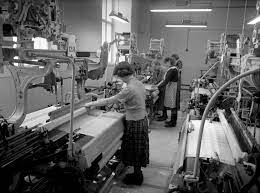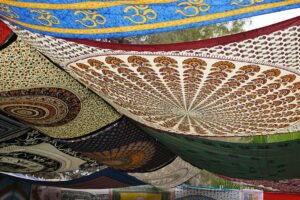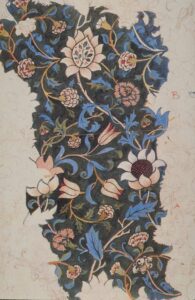Textile art is an ancient craft that weaves together creativity and material, telling stories through fibers and fabrics.
It’s an expressive medium where color, texture, and pattern collide to form stunning visual narratives.
In this article, we’ll explore the intricate world of textile art, from its historical roots to contemporary practices.
Get ready to unravel the threads that make up this fascinating art form and discover how artists are pushing the boundaries with their innovative designs.
Historical Roots Of Textile Art
The origins of textile art are entwined with the very threads of human civilization.
It’s a form that’s been in constant evolution, shaping and being shaped by society’s shifting needs and values.
As we jump into historical tapestries and ancient fabric remnants, we uncover stories of human ingenuity and the cross-pollination of cultures.
Textile art dates back to prehistoric times when early humans discovered that fibers from plants and animals could be woven to create basic necessities.
Over time, this utilitarian craft transformed into an expressive medium.
Richly decorated fabrics once denoted status and power, gracing the palaces of Egypt and the royal courts of Europe.
- The Bayeux Tapestry illustrates the Norman conquest of England and is an exemplary artifact of narrative storytelling through textiles,
- Ancient Peruvian textiles showcase intricacies of color and design that speak volumes about their creators’ sophistication and skill,
- The Silk Road was a crucial artery for the exchange of ideas and techniques, fostering a rich tapestry of cultural and artistic fusion Our journey through the history of textile art reveals a canvas of human expression, from the weaving looms of ancient history to the ornately stitched kimonos of feudal Japan. It’s through these artifacts that we begin to understand the myriad ways in which textile art has been a silent chronicler of human history.
Techniques And Materials Used In Textile Art
Textile art encompasses a myriad of techniques that artists Use to express their creativity.
Weaving, one of the earliest methods, involves intertwining threads to form fabric, while embroidery entails decorating the fabric with needle and thread for added texture and design.
- Knotting and braiding – used to create intricate patterns,
- Quilting – involves sewing multiple layers of fabric together for both durability and design,
- Appliqué – attaching pieces of fabric onto a larger base to form pictures or patterns.
The choice of materials in textile art is as diverse as the techniques themselves.

Traditional fibers like wool, cotton, and silk have been staples in textile creations for centuries.
Nonetheless, modern textile artists frequently experiment with unconventional materials, incorporating anything from synthetic fibers to recycled plastics, showcasing that the realm of textile art is boundless.
Artists also blend various techniques to forge unique pieces, for instance, marrying dyeing practices with weaving or embroidery.
This fusion results in dimensional and tactile works that transcend the fabric’s mere utility, transforming it into evocative statements.
As we jump further into textile art, we cannot overlook the technological strides that have opened new doors for artists.
Digital weaving and computerized embroidery machines have catapulted textile art into the future, enabling the production of elaborate, precision-based designs that would have been near impossible to achieve by hand.
The versatility of textile art is evident not only in the techniques and materials used but also in the seamless adaptability to both traditional and innovative expressions.
Whether through hand-dyed batik or digitally-printed fabrics, the evolution of these methods continues to enrich the tapestry of textile art.
Exploring Different Styles And Forms Of Textile Art
As we jump into the myriad styles and forms of textile art, it’s vital to recognize that each piece reflects its creator’s narrative and cultural environment.
For instance, Shibori, a Japanese technique, offers intricate patterns through resist-dyeing, while African Kente cloth weaves together vibrant colours and symbols, each telling a unique story of social and spiritual values.
Textile art can be brilliantly experimental, often stretching beyond the familiar boundaries of traditional craft.
Artists like Anni Albers and Sheila Hicks broke the mold with their works, merging the tactile and the visual to produce textiles that challenge our perception of materials and their application.
- Some influential styles include: – Tapestry – often depicting historical and mythological scenes – Embroidery – featuring delicate threadwork to create complex images – Art Quilts – where color, shape, and stitching unite to form contemporary narratives.
In the realm of digital media, textile artists are also harnessing technology to bring an ancient craft into the future.
Digital looms and software like Adobe
This marriage of old and new broadens the audience for textile art, illustrating its timeless relevance and adaptability.

Our love for cinema also informs how we perceive textile arts.
Just as film can encompass an array of genres and narratives, textile art is equally diverse.
The backdrops and costumes seen in films like Cleopatra or The Grand Budapest Hotel showcase the integral role textiles play in visual storytelling, and they point to the fact that fabric itself can be a canvas for historical and cultural dialogue.
From intricate paisleys that trace the routes of ancient trade to wearable art that conveys modern social commentary, textile art remains an ever-evolving form of expression that transcends eras and geographies.
Whether through stitches, dyes, or digital prints, textile artists continue to weave their stories into the very fabric of our shared history.
Textile Art In Contemporary Practices
We often find that contemporary textile artists are pushing the envelope, blurring the lines between traditional craft and contemporary art.
We see a bold exploration of themes like identity, politics, and sustainability through the medium of textile.
For instance, the work of Faith Ringgold in Tar Beach is a powerful narrative quilt that combines storytelling with fabric, providing a rich commentary on race and gender.
Our examination of textile art in the modern era reveals a landscape where technology and tradition intersect.
Artists leverage tools like digital looms and computer software to expand the possibilities of textile design and creation.
This fusion results in innovative works that could not have been conceived in earlier times.
The advent of wearable technology and smart textiles is another exciting frontier, merging fashion, function, and art in unprecedented ways.
Key features of contemporary textile art often include:
- Incorporation of digital imagery and techniques,
- Fusion of various materials and methods,
- Engagement with social and environmental issues.
We recognize that textile art is no longer confined to the walls of galleries and museums.
It’s moved into the public sphere through installations, performances, and interactive pieces.
Sonya Clark’s Unraveling and Unraveled performances, for example, involved the deconstruction of a Confederate flag, inviting dialogue on history and race.
The versatility of textiles allows for a collaborative approach as well.
Filmmakers and stage designers frequently Use textile art to create immersive environments that enhance storytelling.
In the acclaimed film Marie Antoinette, costume designer Milena Canonero extensively used textiles to evoke the opulence of the French court.
We’re excited to jump deeper into how contemporary artists are defining and redefining the boundaries of this art form.
With each new technique and piece, textile art continues to serve not only as an aesthetic experience but also as a compelling conduit for conversation and community engagement.
Innovative Designs And Approaches In Textile Art
In the realm of textile art, innovation knows no bounds.
Artists are constantly pushing the envelope, seamlessly blending ancient crafts with modern innovations to create astonishing pieces that transcend traditional limits.
Sustainable materials and eco-conscious methods are at the forefront of new textile art.
We see a marked increase in artists sourcing environmentally friendly fibers and dyes, focusing on the lifecycle of their creations.
This isn’t just a trend; it’s a movement toward a more responsible practice in art-making.
Our journey through textile art wouldn’t be complete without acknowledging the digital revolution’s impact.
The introduction of digital looms and textile printers has revolutionized the way artists work, allowing for intricate patterns and designs that were once impossible or extremely time-consuming.
- The use of LED threads and electronic components enables textiles to glow and change color,
- Smart textiles react to external stimuli, such as light and sound, creating an interactive experience,
- 3D printing onto fabric introduces a textural dimension previously restricted to rigid materials.
Collaborations across disciplines are increasingly common, as textile artists partner with scientists and technologists.
Together, they break new ground in functionality and aesthetics, resulting in wearable pieces that double as high-tech gear or installations that engage audiences in immersive narratives.
Beyond the tangible, we’re seeing a surge in conceptual textiles.
Artists like Anni Albers and Olga de Amaral have been pivotal in elevating textiles into the realm of high art, where the idea is as powerful as the technique.
Contemporary practitioners are following suit, weaving in themes of identity and social commentary, ensuring that each piece is rich in meaning and context.
What we’re witnessing is the rise of textile art as a dynamic form of expression that straddles craft, design, technology, and art.
It’s a space where functional objects become conduits of larger conversations and where the warp and weft of fabric tell tales as complex as any canvas.
What Is Textile Art – Wrap Up
We’ve journeyed through the rich tapestry of textile art, from its ancient roots to the innovative frontiers it’s exploring today.
Textile art isn’t just about the materials or techniques; it’s a powerful storytelling medium that continues to evolve, reflecting our identities, politics, and the world around us.
It transcends traditional boundaries, engaging communities and sparking conversations that resonate on a global scale.
As we’ve seen, the fusion of technology and tradition in textile art is not only pushing creative limits but also highlighting important social and environmental narratives.
Whether through sustainable practices or digital integration, textile art remains a dynamic and inclusive form of expression, demonstrating that it’s as relevant and transformative today as it has ever been.
Frequently Asked Questions
What Is Textile Art And How Has It Evolved?
Textile art is a form of craft that involves the creation of artwork using fibers as the primary medium.
Historically, it has evolved from purely utilitarian uses to become a sophisticated expressive medium that tells stories and showcases cultural identities through techniques like weaving and embroidery.
What Are Some Key Historical Examples Of Textile Art?
Key historical examples of textile art include the Bayeux Tapestry, which depicts the events surrounding the Norman Conquest of England, and the rich tapestries of ancient Peru, which tell stories of those cultures.
How Did The Silk Road Affect Textile Art?
The Silk Road was pivotal in the exchange of ideas and techniques in textile art, facilitating the cross-cultural influences that shaped styles and methods across various civilizations.
What Are The Common Techniques Used In Textile Art?
Textile art utilizes various techniques such as weaving, embroidery, knotting, braiding, quilting, and appliqué to create diverse and intricate works.
What Materials Are Traditionally Used In Textile Art?
Traditional fibers used in textile art include wool, cotton, and silk.
Artists also experiment with unconventional materials to push the boundaries of the craft.
How Are Technology And Tradition Combined In Textile Art?
In contemporary textile art, technology and tradition blend through the use of digital looms, software, and wearable technology, allowing for the creation of innovative works that still respect historical practices.
What Themes Do Contemporary Textile Artists Explore?
Contemporary textile artists explore a range of themes that include identity, politics, and sustainability.

They engage with these issues through their artworks, often incorporating digital and mixed-media elements.
How Has Textile Art Moved Beyond Traditional Displays?
Textile art has expanded beyond galleries and museums, engaging with the public through installations, performances, and interactive pieces.
It collaborates across disciplines, enhancing storytelling in film, theater, and other immersive environments.
What Are The Features Of Contemporary Textile Art?
Contemporary textile art is characterized by the use of sustainable materials, the impact of digital technology on techniques and design, and a shift towards conceptual perspectives that transform functional items into conversation pieces.
How Does Textile Art Contribute To Community Engagement?
Textile art fosters conversation and community engagement by redefining boundaries and serving as a conduit for cultural dialogue.
It invites public interaction and collaborative opportunities, emphasizing the versatility and connective power of textiles.


